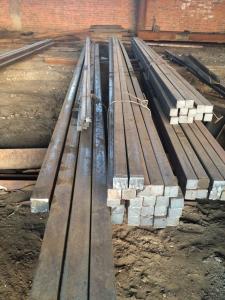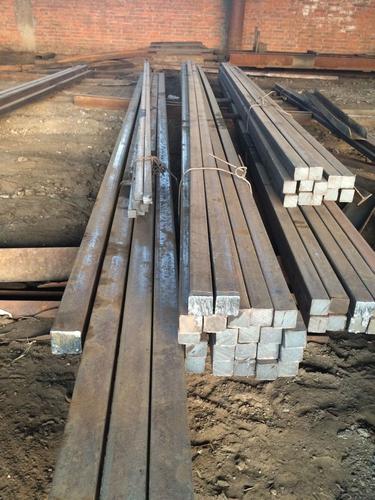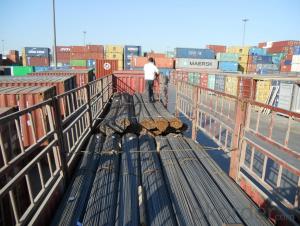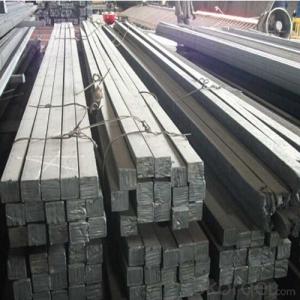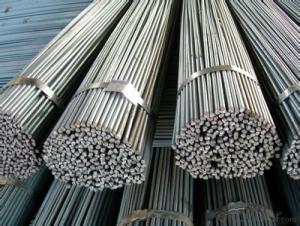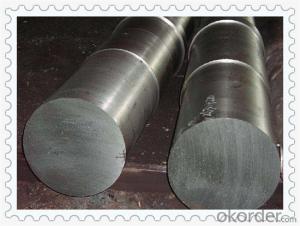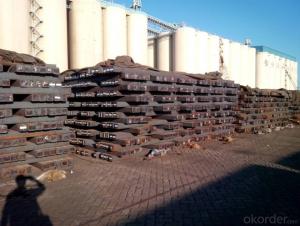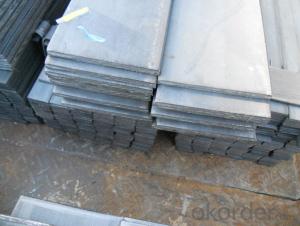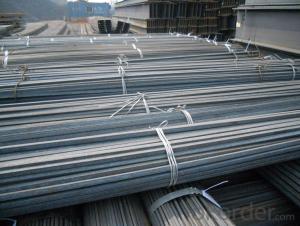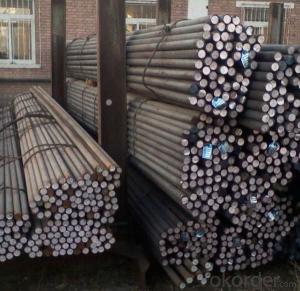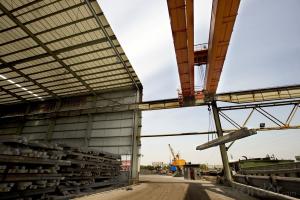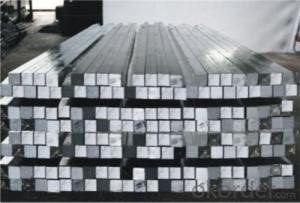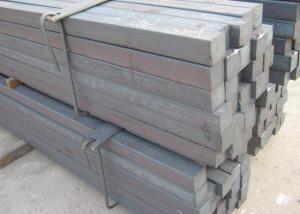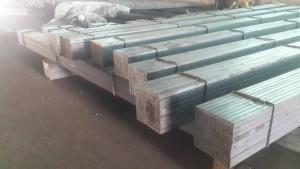Hot Rolled Square Steel Bars Q235
- Loading Port:
- Tianjin
- Payment Terms:
- TT OR LC
- Min Order Qty:
- -
- Supply Capability:
- 200000 m.t./month
OKorder Service Pledge
OKorder Financial Service
You Might Also Like
Hot Rolled Square Bar Details:
| Minimum Order Quantity: | 50Tons | Unit: | m.t. | Loading Port: | Tianjin Port |
| Supply Ability: | 500 tons per month | Payment Terms: | TT or LC |
Product Description:
Specifications of Hot Rolled Square Bar Q235:
-Standard: GB,
-Grade: Q235 or equivalent.
Chemical Composition:
Standard | Grade | Element (%) | ||||
GB | Q235B | C | Mn | S | P | Si |
0.12~0.20 | 0.30~0.70 | ≤0.045 | ≤0.045 | ≤0.30 | ||
Measures of Hot Rolled Square Bar:
(Section of HR Square Bar)
-Length of a side and Theoretical weight of Square Bar.
Length of a side(mm) | Theoretical weight(kg/m) | Length of a side(mm) | Theoretical weight(kg/m) |
6 | 0.283 | 32 | 8.04 |
7 | 0.385 | *33 | 8.55 |
8 | 0.502 | 34 | 9.07 |
9 | 0.636 | *35 | 9.62 |
10 | 0.785 | 36 | 10.17 |
11 | 0.950 | 38 | 11.24 |
12 | 1.13 | 40 | 12.56 |
13 | 1.33 | 42 | 13.85 |
14 | 1.54 | 45 | 15.90 |
15 | 1.77 | 48 | 18.09 |
16 | 2.01 | 50 | 19.63 |
17 | 2.27 | 53 | 22.05 |
18 | 2.54 | *55 | 23.6 |
19 | 2.82 | 56 | 24.61 |
20 | 3.14 | *58 | 26.4 |
21 | 3.46 | 60 | 28.26 |
22 | 3.80 | 63 | 31.16 |
*23 | 4.15 | *65 | 33.17 |
24 | 4.52 | *68 | 36.3 |
25 | 4.91 | 79 | 38.49 |
26 | 5.30 | 75 | 44.16 |
*27 | 5.72 | 80 | 50.24 |
28 | 6.15 | 85 | 56.72 |
*29 | 6.60 | 90 | 63.59 |
30 | 7.06 | 95 | 70.85 |
*31 | 7.54 | 100 | 78.50 |
Notes:
1, The theoretical weights in the list, base on the density of 7.85 g/cm3.
2, Formula for theoretical weight of Square bar: a(length of a side) * a * 0.00785
3, The numbers with *mean that they are not regular or we don’t offer them.
-Regular length of Square Bar:
Steel | Length of a side (mm) | Length of steel (m) |
Normal steel | < 25 | 4~10 |
> 25 | 3~9 | |
Steel of high quality | All measure | 2~6 |
Tool steel >75 | 1~6 |
Usage/Applications of Hot Rolled Square Bar:
-The Square Steel is normally used as structure steel.
-Row material for other structure steel like steel angles, channels, I-beams, H-beams, etc…
-Row material for steel pipes.
Packaging & Delivery of Hot Rolled Square Bar:
-Packing Detail: The products can be packed in bundles by steel wires.
-Marks:
1, Tag marks: the tag marks will be tied up to each bundle of the products. The information is usually including supplier’s logo and name, product name, made in China, products’ specifications, the painted color and other information requested by customers.
2, Color marks: we will paint both ends of the bundles of these products to make sure that they are more evident. It’s will be more convenient for the customers to distinguish them at the destination port.
-Delivery Detail: 30~45 working days after receive buyer’s T.T. or L/C.
Transportation:
-The products can be delivered by bulk vessel or by container. As for container, products with the length of 6m will be loaded in 20’ container, with 9m or 12m, in 40’ container.
-The maximum quantity of loading of container is 25 tons.
-The products are usually transported to the nearest port from the production place.
Payment:
-Invoicing on theoretical weight or actual weight as customer’s request.
-FOB, CFR or CIF.
-Regular terms of payment:
1, 30% payment in advance, the remaining balance (70% payment) against the copy of B/L.
2, 30% payment in advance, the remaining balance (70% L/C) against the copy of B/L.
3, Negotiable.
Photos of Hot Rolled Square Bar:
-Products in the factory:

-Products during transportation:

We sincerely welcome partners around the world to establish business cooperation with us on the basis of mutual trust, benefit and development.
- Q: Can a steel square be used for checking the levelness of a miter saw base?
- No, a steel square cannot be used for checking the levelness of a miter saw base. A steel square is primarily used for measuring and marking right angles, whereas checking the levelness of a miter saw base requires a level or a similar tool designed specifically for that purpose.
- Q: How do you use a steel square to lay out a compound angle cut?
- To use a steel square to lay out a compound angle cut, you would first determine the angles you need to cut. Then, you would align the steel square with the edge of the material and adjust it to match the desired angles. Next, you would mark the cut lines on the material using the square as a guide. Finally, you can use a saw or other cutting tool to make the compound angle cut along the marked lines.
- Q: Can a steel square be used for measuring and marking bevel cuts?
- Utilizing a steel square is indeed possible for the purpose of measuring and marking bevel cuts. This particular tool, referred to as a framing square or rafter square, possesses exceptional versatility in the realm of carpentry tasks, encompassing the act of measuring and marking bevel cuts. Its structure consists of a right-angle shape, featuring an extended arm and a shorter arm, facilitating effortless alignment with the material's cutting edge. Through the manipulation of the square's angle, one can accurately gauge and demarcate the bevel cut on said material. Moreover, the square's steel composition guarantees both resilience and precision, rendering it a dependable implement for carpentry undertakings.
- Q: Can a steel square be used for drywall corner installation?
- Yes, a steel square can be used for drywall corner installation. A steel square is a versatile tool that is commonly used in carpentry and can also be utilized for various tasks in drywall installation, including marking and cutting corners. By using a steel square, you can ensure accurate and precise measurements, which is crucial for achieving seamless and professional-looking corners in drywall installation.
- Q: How do you use a steel square to determine the height of an object?
- To use a steel square to determine the height of an object, you can follow these steps: 1. Place the steel square on a flat surface, ensuring that it is level and stable. 2. Position the object whose height you want to measure next to the steel square. 3. Align the long side of the steel square vertically against the side of the object. Make sure the square is flush against the object's surface. 4. Look at the measurement markings on the steel square. The height of the object will be indicated by the point where the top edge of the object intersects with the measurement scale on the square. 5. Take note of the measurement indicated on the steel square, which represents the height of the object. Note that if the object has an irregular shape or is not flat, you may need to adjust your positioning to find a consistent reference point to measure from. Additionally, it is important to ensure the steel square is accurately calibrated and the measurements are easy to read to obtain precise results.
- Q: How do you use a steel square to measure a roof pitch?
- To use a steel square to measure a roof pitch, you will need to follow these steps: 1. Start by selecting a steel square that has a body and a tongue. The body is usually 24 inches long, and the tongue is usually 16 inches long. 2. Place the body of the steel square along the bottom edge of the roof rafter or truss. Ensure that the square is positioned in a way that the tongue extends vertically towards the peak of the roof. 3. Adjust the square until the edge of the tongue aligns with the bottom edge of the rafter or truss. 4. Once the square is positioned correctly, read the measurement on the body of the square where it intersects with the top edge of the rafter or truss. This measurement represents the rise of the roof. 5. Next, measure the horizontal distance along the body of the square from the bottom edge of the rafter or truss to the point where the tongue intersects the body. This measurement represents the run of the roof. 6. To determine the roof pitch, divide the rise measurement by the run measurement. This will give you a ratio, such as 4:12 or 6:12, which indicates the pitch of the roof. Remember, the pitch of a roof is measured as the vertical rise for every 12 inches of horizontal run. So, a 4:12 pitch means that for every 12 inches of run, the roof rises 4 inches vertically. Using a steel square to measure a roof pitch can be an accurate and convenient method, especially when working with traditional gable roofs. However, it is important to make sure the steel square is properly aligned and that the measurements are taken accurately to ensure precise results.
- Q: Can a steel square be used for checking the squareness of window frames?
- Yes, a steel square can be used for checking the squareness of window frames. A steel square is a versatile tool commonly used in woodworking and construction to ensure accuracy and squareness. It consists of a steel blade with a 90-degree angle at one end and a handle at the other. By placing the steel square against the window frame, one can check if the corners are perfectly perpendicular or if there is any deviation from a right angle. If the steel square does not align properly with the corners, adjustments can be made to ensure the window frame is square before installation.
- Q: Can a steel square be used for checking the flatness of surfaces?
- The flatness of surfaces can be checked using a steel square. This versatile tool is commonly utilized in woodworking and metalworking. It is comprised of a flat, straight edge and a perpendicular, right-angle edge that enables precise measurements and alignments. To assess surface flatness, simply place the steel square on the surface and observe its positioning. If the surface is completely flat, the square will maintain consistent contact along its entire length. Conversely, if the surface is uneven, you will notice gaps or inconsistent contact between the square and the surface. While using a steel square for flatness checks is a quick and straightforward method, it's important to acknowledge that it may not provide the same level of accuracy as specialized tools like a surface plate or straight edge ruler. For critical applications or highly precise measurements, it is advisable to employ more accurate instruments.
- Q: Can a steel square be used for metalworking tasks?
- Yes, a steel square can be used for metalworking tasks. A steel square, also known as a framing square or carpenter's square, is a versatile tool that can be used for measuring, marking, and checking right angles in metalworking projects. It is commonly used for layout work, marking reference lines, and ensuring accurate angles while cutting or fabricating metal pieces.
- Q: How do you use a steel square to measure the width of a picture frame?
- To measure the width of a picture frame using a steel square, you would place one edge of the square against the inside of the frame, ensuring it is flush with the corner. Then, you can read the measurement off the scale on the square where the other edge aligns with the opposite side of the frame. This will give you an accurate measurement of the frame's width.
Send your message to us
Hot Rolled Square Steel Bars Q235
- Loading Port:
- Tianjin
- Payment Terms:
- TT OR LC
- Min Order Qty:
- -
- Supply Capability:
- 200000 m.t./month
OKorder Service Pledge
OKorder Financial Service
Similar products
Hot products
Hot Searches
Related keywords
